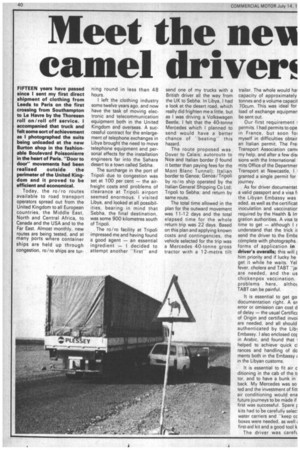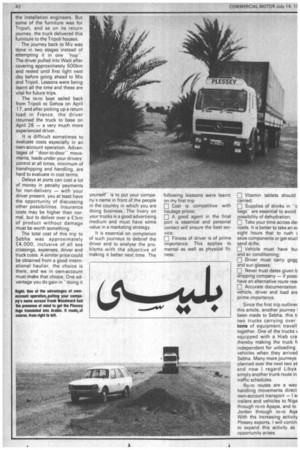Meet the nem camel driven
Page 42

Page 43

Page 44

If you've noticed an error in this article please click here to report it so we can fix it.
FIFTEEN years have passed since I sent my first direct shipment of clothing from Leeds to Paris on the first crossing from Southampton to Le Havre by the Thoresen roll on/roll off service. I accompanied that truck and felt some sort of achievement as I photographed the suits being unloaded at the new Burton shop in the fashionable Boulevard Poissonierre in the heart of Paris. "Door to door" movements had been realised outside the perimeter of the United Kingdom and it proved to be efficient and economical.
Today, the ro/ro routes available to road transport operators spread out from the United Kingdom to all European countries, the Middle East, North and Central Africa„ to Canada and the USA and to the Far East. Almost monthly, new routes are being tested, and at many ports where container ships are held up through congestion, ro/ro ships are tur ning round in less than 48 hours.
I left the clothing industry some twelve years ago, and now have the task of moving electronic and telecommunication equipment both in the United Kingdom and overseas. A successful contract for the enlargement of telephone exchanges in Libya brought the need to move telephone equipment and personal effects for the installation engineers far into the Sahara desert to a town called Sebha.
The surcharge in the port of Tripoli due to congestion was set at 100 per cent — the airfreight costs and problems of clearance at Tripoli airport seemed enormous. I visited Libya, and looked at all possibilities, bearing in mind that Sebha, the final destination, was some 900 kilometres south of Tripoli.
The ro/ro facility at Tripoli impressed me and having found a good agent — an essential ingredient — I decided to attempt another "firstand send one of my trucks with a British driver all the way from the UK to Sebha. In Libya, I had a look at the desert road, which really did frighten me a little, but as I was driving a Volkswagen Beetle, I felt that the 40-tonne Mercedes which I planned to send would have a better chance of -beatingthis hazard.
The route proposed was Dover to Calais; autoroute to Nice and Italian border (I found it better than paying fees for the Mont Blanc Tunnel); Italian border to Genoa; Genoa /Tripoli by ro/ro ship operated by the Italian General Shipping Co Ltd; Tripoli to Sebha; and return by same route.
The total time allowed in the plan for the outward movement was 11-12 days and the total elapsed time for the whole return trip was 22 days. Based on this plan and applying known costs and contingencies, the vehicle selected for the trip was a Mercedes 40-tonne gross tractor with a 12-metre tilt trailer. The whole would ha. capacity of approximately tonnes and a volume capacil 70cum. This was ideal for load of exchange equipmer be sent out.
Our first requirement permits. I had permits to ope in France, but soon foi myself in difficulties obtair an Italian permit. The Frei Transport Association cam( my help, and after a few disi sions with the International mits Office of the Departmer Transport at Newcastle, I granted a single permit for journey.
As for driver documentat a valid passport and a visa t the Libyan Embassy was eded, as well as the certificat inoculation and vaccinatior required by the Health & Irr gration authorities. A visa ta time to get — although I r understand that the trick i! send the driver to the Embz complete with photographs forms of application in driver's overalls; this will c him priority and if lucky he get it while he waits. Yel fever, cholera and TABT "ja are needed, and the us chickenpox vaccination. problems here, althoi. TABT can be painful.
It is essential to get go documentation right. A sr error or omission can cost d of delay — the usual Certificz of Origin and certified invoi are needed, and all should authenticated by the Lib Embassy. I also enclosed cor in Arabic, and found that 1 helped to achieve quick cl rances and handling of do ments both in the Embassy in the Libyan customs.
It is essential to fit air c ditioning in the cab of the ti tor, and to have a bunk in back. My Mercedes was so ted and the investment of fitt air conditioning would ena future journeys to be made if first was successful. Spare kits had to be carefully selec. water carriers and "keep cc boxes were needed, as well first-aid kit and a good tool k
The driver was carefi. d and well briefed in the s of Libya, so that he not be unaware of the law the country he was visiting. A ection of Arabic phrases were ide tip, which the driver could
to try to carry out a "consatin' in case of problems. 3 m les were "Can you direct
to the nearest police stan?" and "Where can I obtain !sel uel?"
A f nal check of the vehicle .lud d regreasing the wheel bs and the fifth-wheel plate, we I as checking the tyres. tvei use retreads or recuts sand roads — it is essential it tyres are in good order and n stand the high temperaes.
Th outfit left on March 27, 178 due in Tripoli on April '3 nd in Sebha on April 5. I w ut to Tripoli to meet the hic e and accompany it to bh , after visiting Sebha to Det wo charter aircraft flying :0 t at airport direct from the Th n the problems started! 1 the truck's arrival at Genoa, e driver was told that the boat id been delayed — no definite asons, and it was difficult to )t accurate information. In ipoli, I contacted the agents id found that one of the ships id broken down, causing hedules to be changed and a :lay of five days for my truck. What a disappointment! -tally on April 10 — eight days ihind schedule — the truck rived in Tripoli and thanks to e ef'orts of an excellent agent, whom I met personally and stressed the importance that my truck had to be cleared first, the truck was moved out of the port within 24 hours. An essential ingredient to achieve this is personal contact and to have copies of all documents sent on to the agent before the truck arrives. This enables entries to be made with customs before the goods arrive. The route to Sebha from Tripoli starts along the coastal road, well known to many who may have made that journey in 1943 with Field Marshall Montgomery -nd his troops. The first town to be reached is Misurrata — approximately five hours from Tripoli on a metalled, but somewhat rough road. The truck stayed the night at Miz, planning an early start for the 600km run across the desert to Sebha. The truck was accompanied by the project manager for Sebha using a Peugeot Estate. the object being that should any problems arise, then help could be called in. On this first trip, it was also decided to use the services of a "guide' who immediately was "lost" once the main coastal road was left behind — he continued as a passenger! The first 100km of road was reasonable and a goad average 40-50 km/h was maintained. Then the road deteriorated and speeds dropped to below 20km/h. It was hot and sandstorms were met on the way— such a journey is very uncomfortable, and it soon became clear that the decision to accompany the truck and not to leave it to a single driver was correct. The road varied between excellent and terrible and care was needed at all times. We made the mistake of pushing on to our destination, but as night fell the lights of Sebha were still a long way in the distance, so it was decided for safety's sake to bed down in the sleeper truck and await first light. Next morning, the driver, his truck, and his companions made an entry into the town of Sebha, feeling just as proud as the 1943 troops who made that road journey from Tobruk to Tripoli. The journey vos not over in Sebha. A charter aircraft had flown new furniture into Sebha, which was to equip the flats for the installation engineers. But some of the furniture was for Tripoli, and so on its return journey, the truck delivered this furniture to the Tripoli houses The journey back to Miz was done in two stages instead of attempting it in one -hop". The driver pulled into VVadi after covering approximately 500km and rested until first light next day before going ahead to Miz and Tripoli. Lessons were being learnt all the time and these are vital for future trips. The ro-ro boat sailed back from Tripoli to Genoa on April 17, and after picking up a return load in France, the driver returned the truck to base on April 26 — a very much more experienced driver. It is difficult sometimes to evaluate costs especially in an own-account operation. Advantages of "door-to-doormovements, loads under your drivers' control at all times, minimum of transhipping and handling, are hard to evaluate in cost terms. Delays at ports can cost a lot of money in penalty payments for non-delivery — with your driver present, you at least have the opportunity of discussing other possibilities. Insurance costs may be higher than normal, but to deliver over a EVam of product without damage must be worth something. The total cost of this trip to Sebha was approximately E4.000, inclusive of all sea crossings, expenses, driver and truck costs. A similar price could be obtained from a good international haulier, the choice is there, and we in own-account must make that choice. One advantage you do gain in -doing it yourselfis to put your company's name in front of the people in the country in which you are doing business. The livery on your trucks is a good advertising medium and must have some value in a marketing strategy. It is essential on completion of such journeys to debrief the driver and to analyse the problems with the objective of making it better next time. The following lesssons were learnt on my first trip Cost is competitive with haulage prices; El A good agent in the final port is essential and personal contact will ensure the best service; [1 Fitness of driver is of prime importance. This applies to mental as well as physical fitness: [1] Vitamin tablets should carried: Supplies of drinks in "c bags'. are essential to avoid possibility of dehydration; El Take your time across de roads It is better to take an e) eight hours that to rush seize components or get studl sand drifts; ▪ Vehicle must have bui and air conditioning; Driver must carry gogc and sun glasses; • Never trust dates given b shipping company — if possi have an alternative route mat El Accurate documentation vehicle, driver and load are prime importance. Since the first trip outline( this article, another journey I been made to Sebha, this ti two trucks carrying over tons of equipment travell together. One of the trucks s, equipped with a Hiab cra thereby making the truck fi independent for unloading vehicles when they arrived Sebha. Many more journeys planned over the next two ye and now I regard Libya simply another trunk route in traffic schedules. Ro-ro routes are a way handling movements direct own-account transport — I si trailers and vehicles to Nige through ro-ro Apapa, and to Jordan through ro-ro Aga With the increasing activity Plessey exports, I will contin to expand this activity as opportunity arises.Tags








































































































































